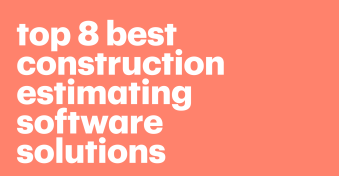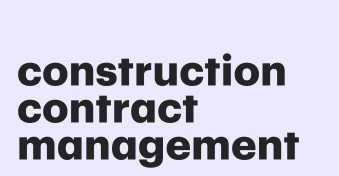In construction, a business proposal is the deciding factor in whether you’ll land a contract.
This multi-page document highlights how you’ll go about realizing the vision of the project.
As a construction company, you need to create a competitive business proposal that will place your brand in a prime position to land lucrative contracts.
We’ll help you explore the contents of a business proposal for construction projects.
Then we’ll show you how to write business proposals with examples.
Key takeaways
- A business proposal for a construction company should contain the costs, market research, scope of work, dates, and roadmap for achieving the project’s vision.
- Construction companies can use digital solutions to speed up the process of drafting, reviewing, and signing business proposals.
- Construction proposals should also contain compelling evidence that the contractor understands industry regulations and trends.
What should a construction business proposal contain?
The first rule of thumb when writing a business proposal is to keep it compelling, complete, and compliant. These are the 3Cs of writing business proposals.
A complete business proposal contains every important project facet in clear and concise detail.
For that same proposal to sound compelling to potential clients, you need to define the scope of work and outline a realistic roadmap for achieving the end goal.
This also involves accounting for pricing and unforeseeable conditions.
And most importantly, your project proposal draft should be compliant with industry standards.
You should also include all permits and licenses from the governing authority in the proposal.
Here are the contents of a construction business proposal:
- Executive summary of the project
- The roadmap covering the scope of work and project vision
- Client contact information (names, phone numbers, addresses, and other vital information)
- Project costs, including the cost of labor, equipment, and miscellaneous expenses
- Project timeline and milestones (start and finish dates)
- A list of subcontractors and team members
- Payment schedule, including acceptable payment options
- Warranty and insurance coverage for unforeseen circumstances
- Penalties and delays
- Safety measures and emergency protocols
- Quality control mechanisms
- Business plan for addressing change orders
- Conditions and procedures for termination
- Certifications, licenses, and permits
For example, contractors working on building projects in California must obtain a general contractor or specialty contractor license from the Contractors State Licensing Board [CSLB].
They are the official body in charge of licensing in California.
How to write a winning business proposal for a construction company
As mentioned, your commercial construction proposal can be a winner if you provide accurate details that make a compelling case for your company to land the contract.
Here are the steps to follow:
1. Conduct market research
When you receive a request for proposal (RFP), you need to touch base with other experts about industry trends.
Your research should focus on cost estimates, changes in regulation, and competitor positioning.

You also need to research the potential client to find out if they have specific preferences.
Gathering this info will help you determine the best approach to crafting a standout bid.
For instance, during the bidding process for a building project, you could determine if the potential client prefers minimalist or maximalist designs.
This will help you tailor your bid to the customer’s needs and make it more relevant.
2. Crunch the numbers
Next up is to estimate how much the construction work will cost you. Some questions to guide you through the process include:
- How much will it cost to hire subcontractors/laborers?
- What is the cost of hiring equipment?
- How much is insurance and licensing?
- What is the project schedule?
Answering these questions will help you decide whether to employ an estimated lump sum or unit price model for generating the service proposal.
3. Outline your goals and organizational information
With the numbers sorted, you need to break down the goals according to the scope of work.
The client will want to know the pathway to success and whether it’s realistic.
For instance, when working on a long-term building project that could run all year, you might need to specify how you intend to work during the rainy or snowy seasons.
The safe bet here is to break your goals down into timelines and milestones in order to make them trackable and quantifiable.
You could add images, graphs, and other additional elements to elaborate.

Another thing to mention in your proposal is the organizational structure.
Some project owners want to drill down to the finest details, including cash flow, penalties for delays, and billable working hours.
4. Work with a professional draft
Once you have all the core details, you can now draft the proposal using a professional proposal template and a custom cover letter.
Ensure to add all important information about financing, licensing, insurance, labor, construction management, etc.
Instead of creating the proposal from scratch, you can download online construction proposal templates to save time and maintain a professional touch.
You just need to input company information and brand identity to personalize it.
Don’t forget to use legible fonts like Arial and Trebuchet to make the text easy to read.
Most importantly, add your permits and licenses to the proposal draft.
5. Review the bid
With the draft ready, you need to examine every line with a microlens.
Go through every digit to make sure your calculations are in order.
Some contracts (especially public works projects) have specific regulations and formatting for proposals. To tick all the required boxes, hire a lawyer or industry expert to review the bid.
6. Send the proposal for consideration
You should always use a digital solution to forward your bid to the project owner or governing body unless the regulations state otherwise.
With construction estimating software, you can decrease the timeline from drafting a contract to getting the final signature.
The best part is that you can keep track of every activity on the proposal document on the same dashboard using audit trails.
7. Save the proposal
If the bid is rejected, you can make changes and reapply.
Otherwise, you can finalize negotiations and start preparing to kick off the project.
If you follow these steps, you stand a high chance of placing the winning bid on every project.
You just have to focus on the core details and clarify every aspect of your proposal.
Examples of business proposals for a construction project
Here is a sample proposal template for construction.
It contains details about the scope of work, insurance and indemnification, deliverables, cost estimates, project overview, and personal information.
Instead of using the same generic template for every project, you can select from an online template library for your specific use case.
We’ll share some of them with you:
Full proposal templates cover entire projects rather than one of their aspects.
For instance, you can write a proposal for a real estate development project or a single residential construction.
Partial proposal templates cover only one aspect of construction services.
You can create a special proposal for roofing or bathroom remodeling.
You can also find special proposal templates for NGOs, nonprofits, and charities.
You might also need a different construction bid proposal format for highly regulated works such as remodels, solar panel installation, and plumbing.
Final thoughts
Writing a business proposal that can land you lucrative construction gigs involves drilling down on the finest details to create a compelling bid.
You need to conduct in-depth market research to determine pricing policies, construction trends, and industry regulations.
You must also personalize your bid to the project owner or government body.
Don’t forget to add estimates, milestones, and timelines for every phase of the project.
Remember to outline security measures as well as all permits and licenses.
Use a free construction proposal template to speed up the proposal drafting process and eliminate potential errors.
To find out how PandaDoc can help you draft and sign construction proposals, visit the learning academy or book a demo with us.
Frequently asked questions
-
To write a business proposal for a construction company, you need to conduct market research to see what competitors are doing. This will help you draft an executive summary and create a roadmap that aligns with the client’s goals. Next, you need to estimate all labor and material costs, factoring in exigent factors and unforeseen circumstances. Then, you can create a professional proposal draft with a personalized touch and consistent brand identity.
-
The three Cs of proposal writing are compelling, complete, and compliant. A compliant proposal has to abide by industry standards. A complete proposal contains all vital details about the project and the pathway to realizing the vision. However, a compelling proposal combines compliance and completeness to guarantee that your bid is best-in-class.
-
A proposal for a construction project is a multi-page document by a potential contractor in which they make their case about why their bid should be accepted over others. Such proposals cover different types of construction projects, including remodeling, maintenance, real estate development, public works, and others.
-
A proposal should have an official format according to specific industry standards. In some cases, you can place your bid using a custom business plan template. But to be on the safe side, research proposal writing best practices for your industry.
Disclaimer
PandaDoc is not a law firm, or a substitute for an attorney or law firm. This page is not intended to and does not provide legal advice. Should you have legal questions on the validity of e-signatures or digital signatures and the enforceability thereof, please consult with an attorney or law firm. Use of PandaDoc services are governed by our Terms of Use and Privacy Policy.


